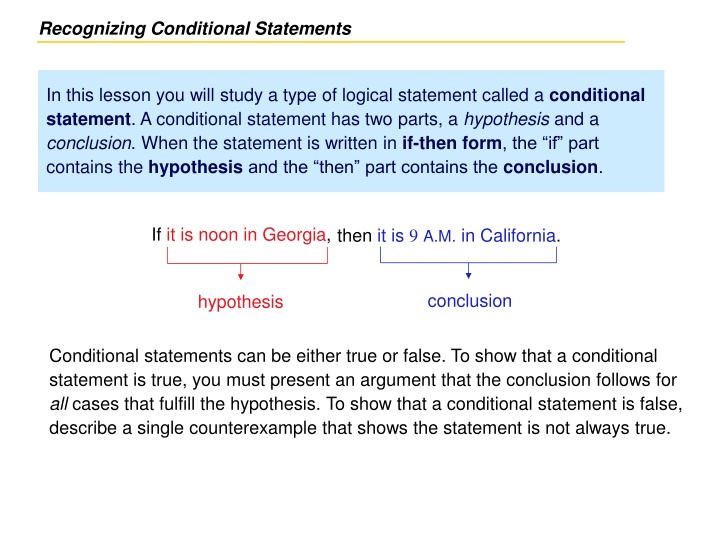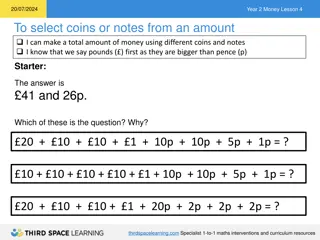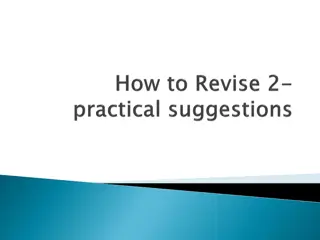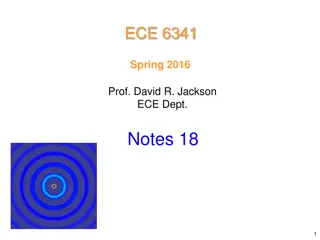
Conditional Statements and Converse Logic
Learn about conditional statements, their structure with a hypothesis and conclusion, how to rewrite statements in if-then form, identify true and false statements, write counterexamples, and understand the converse of a conditional statement. Engage with examples and solutions to deepen your understanding of logical statements.
Download Presentation

Please find below an Image/Link to download the presentation.
The content on the website is provided AS IS for your information and personal use only. It may not be sold, licensed, or shared on other websites without obtaining consent from the author. If you encounter any issues during the download, it is possible that the publisher has removed the file from their server.
You are allowed to download the files provided on this website for personal or commercial use, subject to the condition that they are used lawfully. All files are the property of their respective owners.
The content on the website is provided AS IS for your information and personal use only. It may not be sold, licensed, or shared on other websites without obtaining consent from the author.
E N D
Presentation Transcript
Recognizing Conditional Statements In this lesson you will study a type of logical statement called a conditional statement. A conditional statement has two parts, a hypothesis and a conclusion. When the statement is written in if-then form, the if part contains the hypothesisand the then part contains the conclusion. If it is noon in Georgia, then it is 9A.M. in California. conclusion hypothesis Conditional statements can be either true or false. To show that a conditional statement is true, you must present an argument that the conclusion follows for all cases that fulfill the hypothesis. To show that a conditional statement is false, describe a single counterexample that shows the statement is not always true.
Rewriting in If-Then Form Rewrite the conditional statement in if-then form. Two points are collinear if they lie on the same line. SOLUTION If two points lie on the same line, then they are collinear.
Rewriting in If-Then Form Rewrite the conditional statement in if-then form. Two points are collinear if they lie on the same line. All sharks have a boneless skeleton. SOLUTION If two points lie on the same line, then they are collinear. If a fish is a shark, then it has a boneless skeleton.
Rewriting in If-Then Form Rewrite the conditional statement in if-then form. Two points are collinear if they lie on the same line. All sharks have a boneless skeleton. A number divisible by 9 is also divisible by 3. SOLUTION If two points lie on the same line, then they are collinear. If a fish is a shark, then it has a boneless skeleton. If a number is divisible by 9, then it is divisible by 3 .
Writing a Counterexample Write a counterexample to show that the following conditional statement is false. If x2 = 16, then x = 4. SOLUTION As a counterexample, let x = 4. The hypothesis is true, because ( 4)2 = 16. However the conclusion is false. This implies that the given conditional statement is false.
Recognizing Conditional Statements The converse of a conditional statement is formed by switching the hypothesis and the conclusion. If you see lightning, then you hear thunder. Statement: Converse: If you hear thunder, then you see lightning.
Writing the Converse of a Conditional Statement Write the converse of the following conditional statement. Statement: If two segments are congruent, then they have the same length. SOLUTION Converse: If two segments have the same length, then they are congruent.
Writing the Converse of a Conditional Statement Write the converse of the following conditional statement. Statement: If two segments are congruent, then they have the same length. SOLUTION Converse: If two segments have the same length, then they are congruent. A statement can be altered by negation, that is, by writing the negative of the statement. Statement m A = 30 Negation m A 30 Ais acute. Ais not acute. When you negate the hypothesis and conclusion of a conditional statement, you form the inverse. When you negate the hypothesis and conclusion of the converse of a conditional statement, you form the contrapositive.
Recognizing Conditional Statements When two statements are both true or both false, they are called equivalent statements. A conditional statement is equivalent to its contrapositive. Similarly, the inverse and converse of any conditional statement are equivalent. This is shown in the table below. If m A = 30 , then Ais acute. Original Ifm A 30 , then Ais not acute. Inverse both true both false If Ais acute, thenm A = 30 . Converse If Ais not acute, thenm A 30 . Contrapositive
Writing an Inverse, Converse, and Contrapositive Write the inverse, converse, and contrapositive of the statement. If there is snow on the ground, then flowers are not in bloom. SOLUTION If there is no snow on the ground, then flowers are in bloom. Inverse: Converse: If flowers are not in bloom, then there is snow on the ground. If flowers are in bloom, then there is no snow on the ground. Contrapositive:
Identifying Postulates Use the diagram to give examples of postulates 1 through 7. There is exactly one line (line n) that passes through the points A and B. Postulate 1 Line n contains at least two points. For instance, line n contains the points A and B. Postulate 2 Lines m and n intersect at point A. Postulate 3
Identifying Postulates Use the diagram to give examples of postulates 1 through 7. Plane P passes through the noncollinear points A, B, and C. Postulate 4 Plane P contains at least three noncollinear points, A, B, and C. Postulate 5 Points A and B lie in plane P. So, line n, which contains points A and B, also lies in plane P. Postulate 6 Planes P and Q intersect. So, they intersect in a line, labeled in the diagram as line m. Postulate 7
Using Postulates and Counterexamples Decide whether the statement is true or false. If it is false, give a counterexample. A line can be in more than one plane. SOLUTION In the diagram, line k is in the plane S and line k is in plane T. So, it is true that a line can be in more than one plane.
Using Postulates and Counterexamples Decide whether the statement is true or false. If it is false, give a counterexample. A line can be in more than one plane. SOLUTION In the diagram, line k is in the plane S and line k is in plane T. So, it is true that a line can be in more than one plane. Four noncollinear points are always coplanar. SOLUTION Consider the points A, B, C, and D. The points A, B,and C lie in a plane, but there is no plane that contains all four points. So, as shown in the counterexample, it is false that four noncollinear points are always coplanar.
Using Postulates and Counterexamples Decide whether the statement is true or false. If it is false, give a counterexample. Two nonintersecting lines can be noncoplanar. SOLUTION In the diagram, line m and line n are nonintersecting and are also noncoplanar. So, it is true that two nonintersecting lines can be noncoplanar.






















